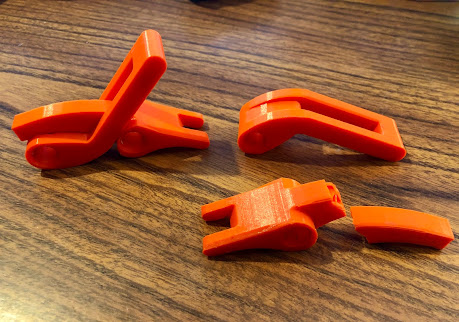A 3D Printed CT90 Valve Spring Compression Tool
Since I picked up a 3D printer this Christmas, I've really found that it's a great tool, especially if you have a good 3D modeling program on your computer and reasonable skills to be able to design the part you would like to print.
For a limited time I am including for free one of my prototype valve spring compression tools that I describe below with the purchase of my clutch holding tool available here at this link.
My fundamental problem has been that I keep coming up with new designs I would like to print and get them 90% complete, before I get another idea and I'm off on another tangent (such is the life of a retired guy...). One of those designs is a Valve Spring Compression tool to use on a Honda CT90.
I've been using a C-Clamp and simple piece of tubing as my valve spring compression tool up until now and it always works and gets the job done. I've done a post here at my blog on the C-Clamp tool here at this link.
I had an idea and used my ViaCad 2D/3D to model the two parts below that make up the valve spring compressor design.
The idea behind the design is that the rightmost part in the picture above acts like a rocker arm and is rotated when a cam profile on the lift part is rotated by the integral lever on that part.I went through a number of different configurations of the designs until I found one that worked just right. The challenge with the design is that you have to create enough travel to compress the spring far enough so the keepers can be removed, but the have the right profile so that when the pressure is released off the spring that it doesn't clamp the tool in the head to where it can't be removed.
In the end I arrived at the design which consists of the two parts shown in the picture below.
I also made a short video at the link below to show how the tool actually works in use.
As I show in the video, the part isn't 100% ready for prime time. The design works just fine, but I have had a failure or two after 10 or 15 uses, so it isn't as robust as I would like. Durability isn't really an issue with a 3D printed tool like this if you have your own printer as you can just print a new tool.
I plan on looking at changing some of the internal printing settings to increase the percent fill or add additional solid layers throughout the design. The current parts I have printed have been made with PETG and I may look at picking up a spool of nylon filament to see if I can get a significant increase in strength.
I'll try and update this post when I get to a final design/material configuration, but I think I'm 90 to 95% of the way there.
I hope you found this interesting and maybe this will spark a few similar designs from others who have 3D printers.




I admire your ingenuity, Michael! Is it worth-ed to have it patented? Good luck!
ReplyDelete